IPM Adoption in Common Beans in Brazil
Abstract
1. Introduction
2. Materials and Methods
2.1. Common Bean Producing Regions Represented in the Study
2.2. Sampling Procedure
2.3. Methodological Concerns
2.4. Data Analysis
2.5. Concepts Used in the Analysis
3. Results
3.1. Respondents Profile
3.2. IPM Adoption by Common Bean Producers in Brazil
3.3. Use of IPM Tools by Common Bean Producers in Brazil
3.4. Perception of IPM Adoption Benefits
3.5. Willingness to Adopt Novel Technologies
4. Discussion
5. Conclusions
Supplementary Materials
Author Contributions
Funding
Data Availability Statement
Acknowledgments
Conflicts of Interest
References
- Uebersax, M.A.; Cichy, K.A.; Gomez, F.E.; Porch, T.G.; Heitholt, J.; Osorno, J.M.; Kamfwa, K.; Snapp, S.S.; Bales, S. Dry beans (Phaseolus vulgaris L.) as a vital component of sustainable agriculture and food security—A review. Legume Sci. 2023, 5, e155. [Google Scholar] [CrossRef]
- Singh, S. Common bean (Phaseolus vulgaris L.). In Genetic Resources, Chromosome Engineering, and Crop Improvement; CRC Press: Boca Baton, FL, USA, 2005; Volume 1, ISBN 978-0-367-38240-7. [Google Scholar]
- Cortés, A.J. On the origin of the common bean (Phaseolus vulgaris L.). Am. J. Plant Sci. 2013, 4, 1998–2000. [Google Scholar] [CrossRef]
- Instituto Brasileiro de Geografia e Estatística (IBGE). Levantamento Sistemático da Produção Agrícola—LSPA. Available online: https://www.ibge.gov.br (accessed on 31 March 2025).
- Food and Agriculture Organization of the United Nations (FAO). Bean Production—FAO [Dataset]. “Production: Crops and Livestock Products” [Original Data]. Available online: https://ourworldindata.org/grapher/bean-production (accessed on 12 March 2025).
- Instituto Brasileiro de Geografia e Estatística (IBGE). Censo Agropecuário. Available online: https://censoagro2017.ibge.gov.br/ (accessed on 31 March 2025).
- Companhia Nacional de Abastecimento (CONAB). Planilhas de Custo de Produção—Feijão [Production Costs Sheets—Beans]. Available online: https://www.conab.gov.br/info-agro/custos-de-producao/planilhas-de-custo-de-producao/itemlist/category/809-feijao (accessed on 31 March 2025).
- Souza, T.L.P.O.; Faria, J.C.; Aragão, F.J.L.; Peloso, M.J.D.; Faria, L.C.; Wendland, A.; Aguiar, M.S.; Quintela, E.D.; Melo, C.L.P.; Hungria, M.; et al. Agronomic performance and yield stability of the RNA interference-based bean golden mosaic virus-resistant common bean. Crop Sci. 2018, 58, 579–591. [Google Scholar] [CrossRef]
- Demeneix, B.A. How fossil fuel-derived pesticides and plastics harm health, biodiversity, and the climate. Lancet Diabetes Endocrinol. 2020, 8, 462–464. [Google Scholar] [CrossRef]
- Smith, R.; van den Bosch, R.; Hagen, K.; Stern, V. The integration of chemical and biological control of the spotted alfalfa aphid: The integrated control concept. Hilgardia 1959, 29, 81–101. Available online: https://scispace.com/pdf/the-integration-of-chemical-and-biological-control-of-the-pcl1r74huk.pdf (accessed on 31 March 2025). [CrossRef]
- Stern, V.M.; Smith, R.F.; Van Den Bosch, R.; Hagen, K.S. The Integrated Control Concept. Available online: https://garfield.library.upenn.edu/classics1985/A1985ASA4600002.pdf (accessed on 31 March 2025).
- Smith, R.F. The importance of economic injury levels in the development of integrated pest control programs. Qual. Plant. Mater. Veg. 1969, 17, 81–92. [Google Scholar] [CrossRef]
- Ryalls, J.M.W.; Garratt, M.P.D.; Spadaro, D.; Mauchline, A.L. The benefits of integrated pest management for apple depend on pest type and production metrics. Front. Sustain. Food Syst. 2024, 8, 1321067. [Google Scholar] [CrossRef]
- Gonzalez, F.; Rodríguez, C.; Oehlschlager, C. Economic benefits from the use of mass trapping in the management of diamondback moth, Plutella xylostella, in Central America. Insects 2023, 14, 149. [Google Scholar] [CrossRef]
- Larochelle, C.; Alwang, J.; Travis, E.; Barrera, V.H.; Andrade, J.M.D. Did you really get the message? Using text reminders to stimulate adoption of agricultural technologies. J. Dev. Stud. 2019, 55, 548–564. [Google Scholar] [CrossRef]
- Bentley, J.W.; Danielsen, S.; Phiri, N.; Tegha, Y.C.; Nyalugwe, N.; Neves, E.; Hidalgo, E.; Sharma, A.; Pandit, V.; Sharma, D.R. Farmer responses to technical advice offered at plant clinics in Malawi, Costa Rica and Nepal. Int. J. Agric. Sustain. 2018, 16, 187–200. [Google Scholar] [CrossRef]
- Aristizábal, L.F.; Johnson, M.; Shriner, S.; Hollingsworth, R.; Manoukis, N.C.; Myers, R.; Bayman, P.; Arthurs, S.P. Integrated pest management of coffee berry borer in Hawaii and Puerto Rico: Current status and prospects. Insects 2017, 8, 123. [Google Scholar] [CrossRef]
- Chaves, B.; Riley, J. Determination of factors influencing integrated pest management adoption in coffee berry borer in Colombian farms. Agric. Ecosyst. Environ. 2001, 87, 159–177. [Google Scholar] [CrossRef]
- Bueno, A.F.; Panizzi, A.R.; Hunt, T.E.; Dourado, P.M.; Pitta, R.M.; Gonçalves, J. Challenges for adoption of integrated pest management (IPM): The soybean example. Neotrop. Entomol. 2021, 50, 5–20. [Google Scholar] [CrossRef]
- Gill, H.K.; Goyal, G. Integrated Pest Management (IPM): Environmentally Sound Pest Management; BoD—Books on Demand: Norderstedt, Germany, 2016; ISBN 978-953-51-2612-6. [Google Scholar]
- IBM Corp. IBM SPSS Statistics for Windows, Version 27.0; IBM Corp.: Armonk, New York, USA, 2020.
- Microsoft Corporation. Microsoft Excel, Version 2504; Microsoft Corporation: Redmond, WA, USA, 2025.
- R Core Team. R: A Language and Environment for Statistical Computing; R Core Team: Vienna, Austria, 2025. [Google Scholar]
- Bortolotto, O.C.; Pomari-Fernandes, A.; Bueno, R.C.O.F.; Bueno, A.F.; da Cruz, Y.K.; Sanzovo, A.; Ferreira, R.B. The use of soybean integrated pest management in Brazil: A review. Agron. Sci. Biotechnol. 2015, 1, 25. [Google Scholar] [CrossRef]
- Onamu, E.M.; Mutyambai, D.M.; Nyangau, I.M.; Nderitu, J.H.; Kasina, M.; Kilalo, D.C.; Mweke, A.N. Farmers’ knowledge, perceptions, and management practices of false codling moth (Thaumatotibia leucotreta) in smallholder Capsicum sp. cropping systems in Kenya. Horticulturae 2024, 10, 331. [Google Scholar] [CrossRef]
- Bryant, T.B.; Greene, J.K.; Reisig, D.; Reay-Jones, F.P.F. Grower perceptions and adoption of IPM and non-Bt refuge in field corn: A survey in North and South Carolina. J. Integr. Pest Manag. 2024, 15, 4. [Google Scholar] [CrossRef]
- Allahyari, M.S.; Damalas, C.A.; Ebadattalab, M. Determinants of integrated pest management adoption for olive fruit fly (Bactrocera oleae) in Roudbar, Iran. Crop Prot. 2016, 84, 113–120. [Google Scholar] [CrossRef]
- Bottrell, D.G.; Schoenly, K.G. Integrated pest management for resource-limited farmers: Challenges for achieving ecological, social and economic sustainability. J. Agric. Sci. 2018, 156, 408–426. [Google Scholar] [CrossRef]
- Ma, W.; Abdulai, A. IPM adoption, cooperative membership and farm economic performance: Insight from apple farmers in China. China Agric. Econ. Rev. 2018, 11, 218–236. [Google Scholar] [CrossRef]
- de Souza Filho, H.M. The Adoption of Sustainable Agricultural Technologies: A Case Study in the State of Espírito Santo, Brazil, 1st ed.; Routledge: Aldershot, UK; Brookfield, WI, USA; Singapore, 1997; ISBN 978-1-84014-160-3. [Google Scholar]
- Clausen, A.S.; Jørs, E.; Atuhaire, A.; Thomsen, J.F. Effect of integrated pest management training on Ugandan small-scale farmers. Environ. Health Insights 2017, 11, 1178630217703391. [Google Scholar] [CrossRef] [PubMed]
- Lane, D.E.; Walker, T.J.; Grantham, D.G. IPM adoption and impacts in the United States. J. Integr. Pest Manag. 2023, 14, 1. [Google Scholar] [CrossRef]
- Sun, X.; Lyu, J.; Ge, C. Knowledge and farmers’ adoption of green production technologies: An empirical study on IPM adoption intention in major indica-rice-producing areas in the Anhui province of China. Int. J. Environ. Res. Public. Health 2022, 19, 14292. [Google Scholar] [CrossRef] [PubMed]
- Sarapura, S.; Chulunbataar, D.C. Institutionalizing Farmer Field School Approach: Experiences from Latin America; FAO: Rome, Italy, 2018; ISBN 978-92-5-130334-4. [Google Scholar]
- Hurley, T.M. Shock and awe pest management: Time for change. Choices Mag. Food Farm Resour. Issues 2016, 31, 1–8. [Google Scholar] [CrossRef]
- Moinina, A.; Lahlali, R.; MacLean, D.; Boulif, M. Farmers’ knowledge, perception and practices in apple pest management and climate change in the Fes-Meknes region, Morocco. Horticulturae 2018, 4, 42. [Google Scholar] [CrossRef]
- Barbosa, F.R.; Martins, F.A.D.; Oliveira, L.F.C.; Silva, A.G.; Gonzaga, A.C.O. Sistema de Produção Integrada do Feijão-Comum na Região Central Brasileira; Embrapa Arroz e Feijão: Santo Antônio de Goias, Brazil, 2018; Volume 245. [Google Scholar]

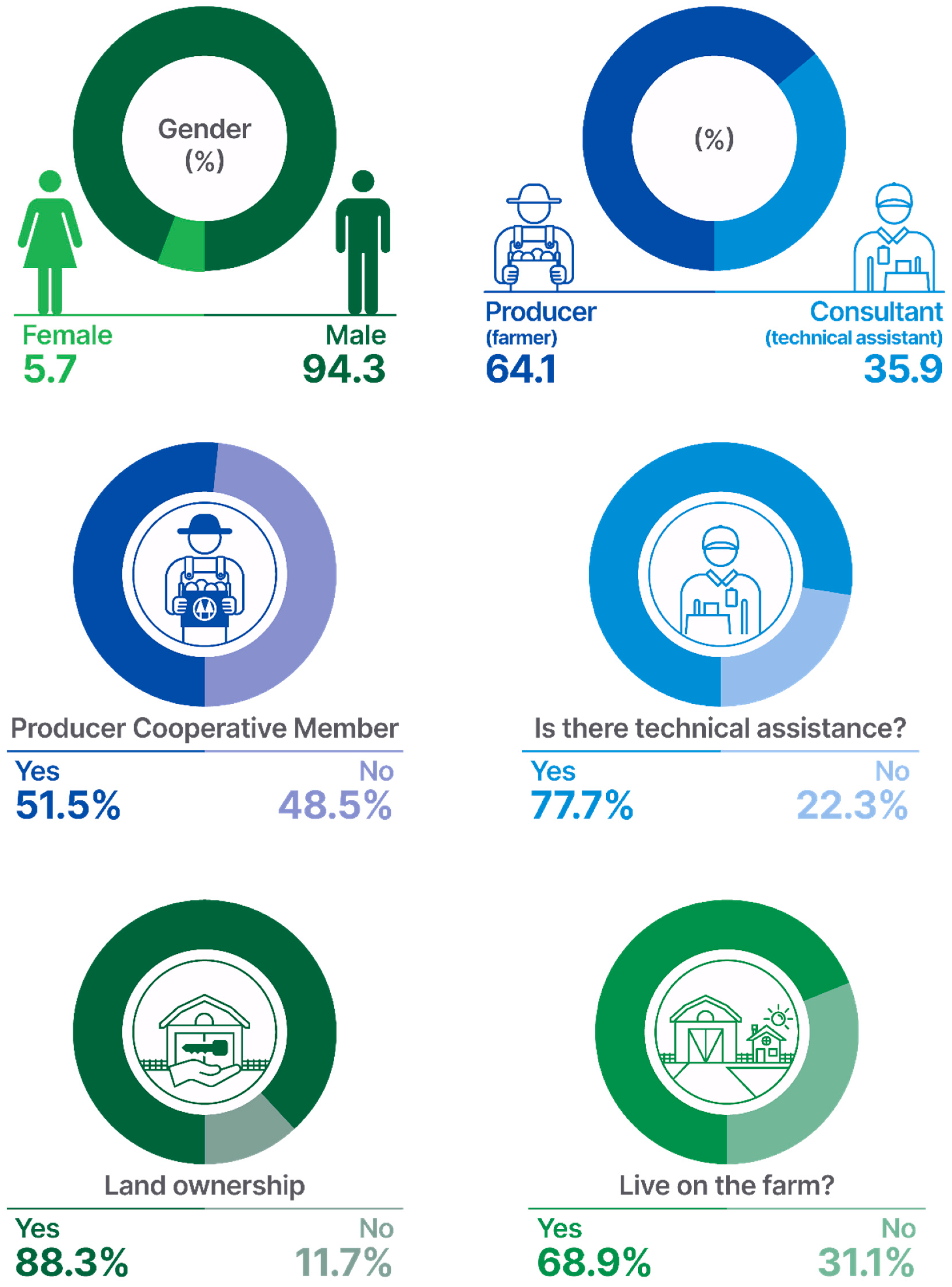
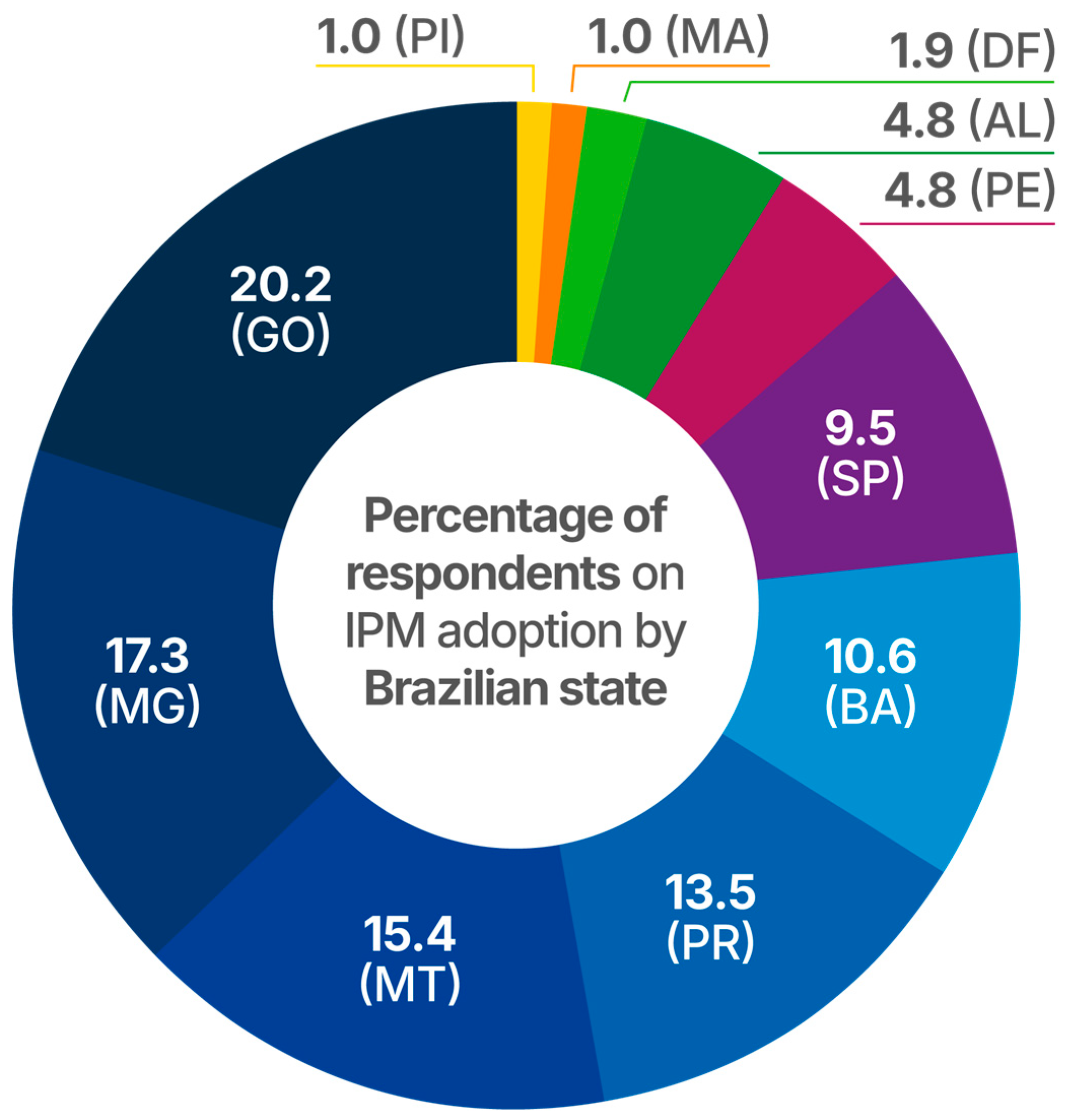

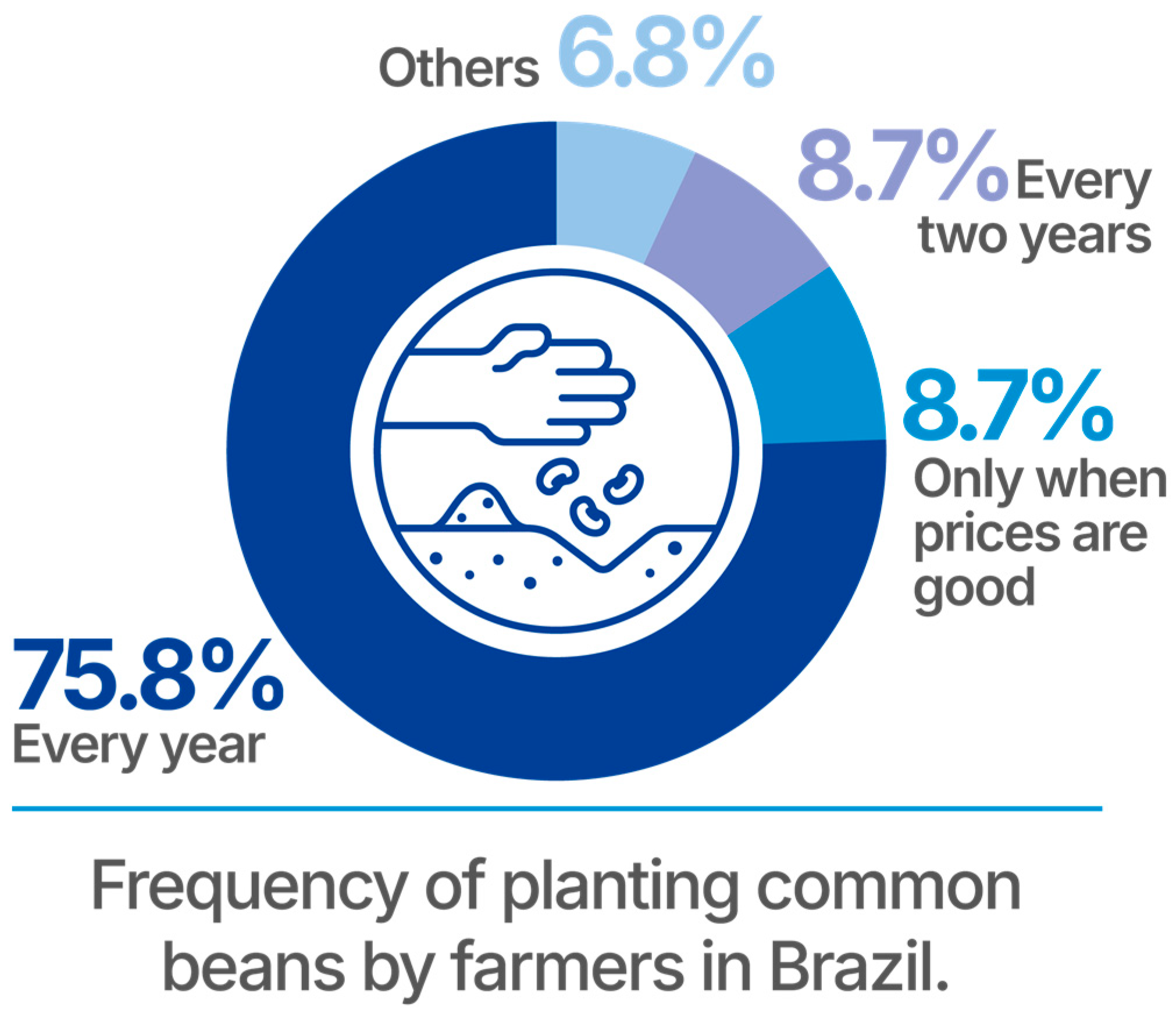


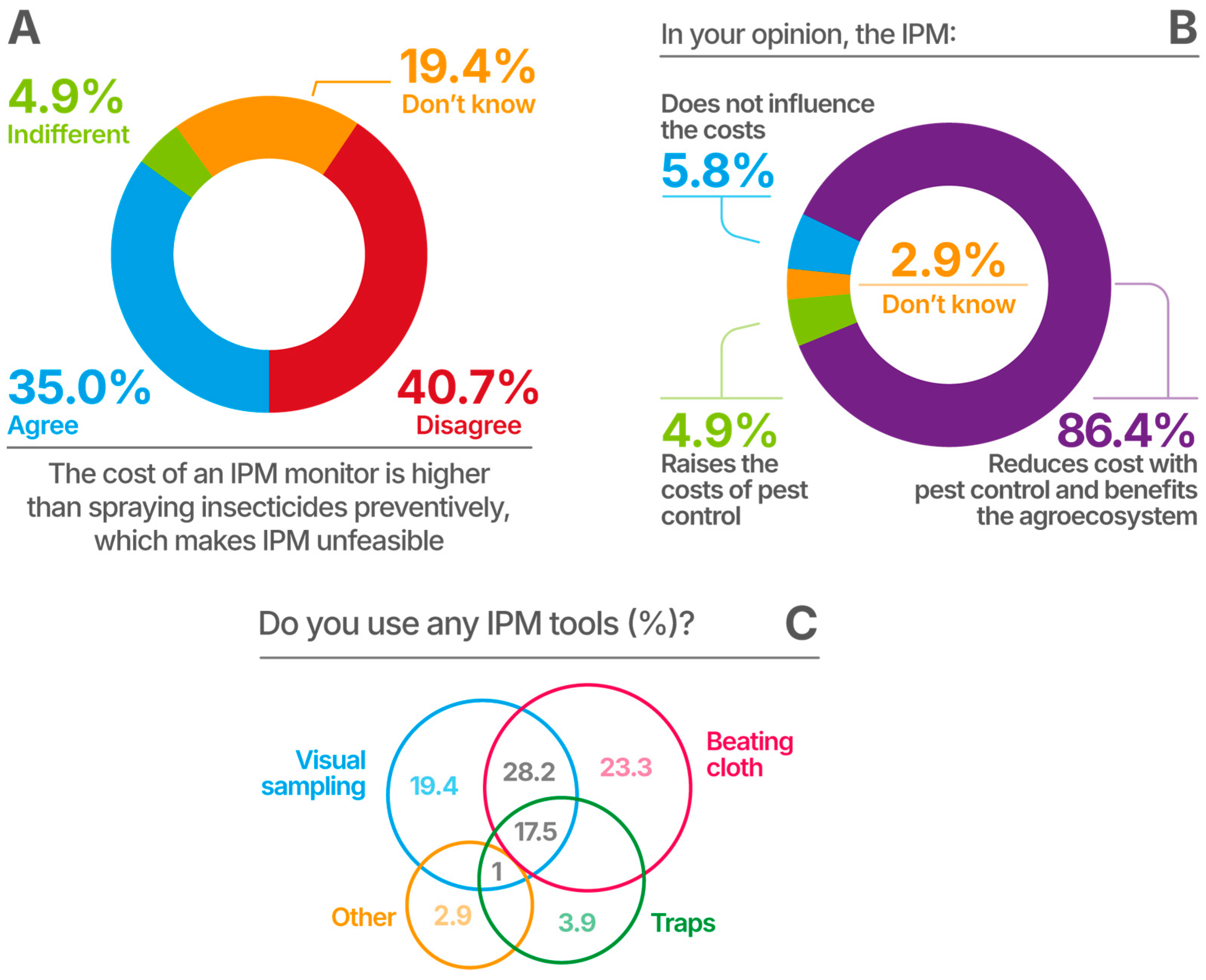

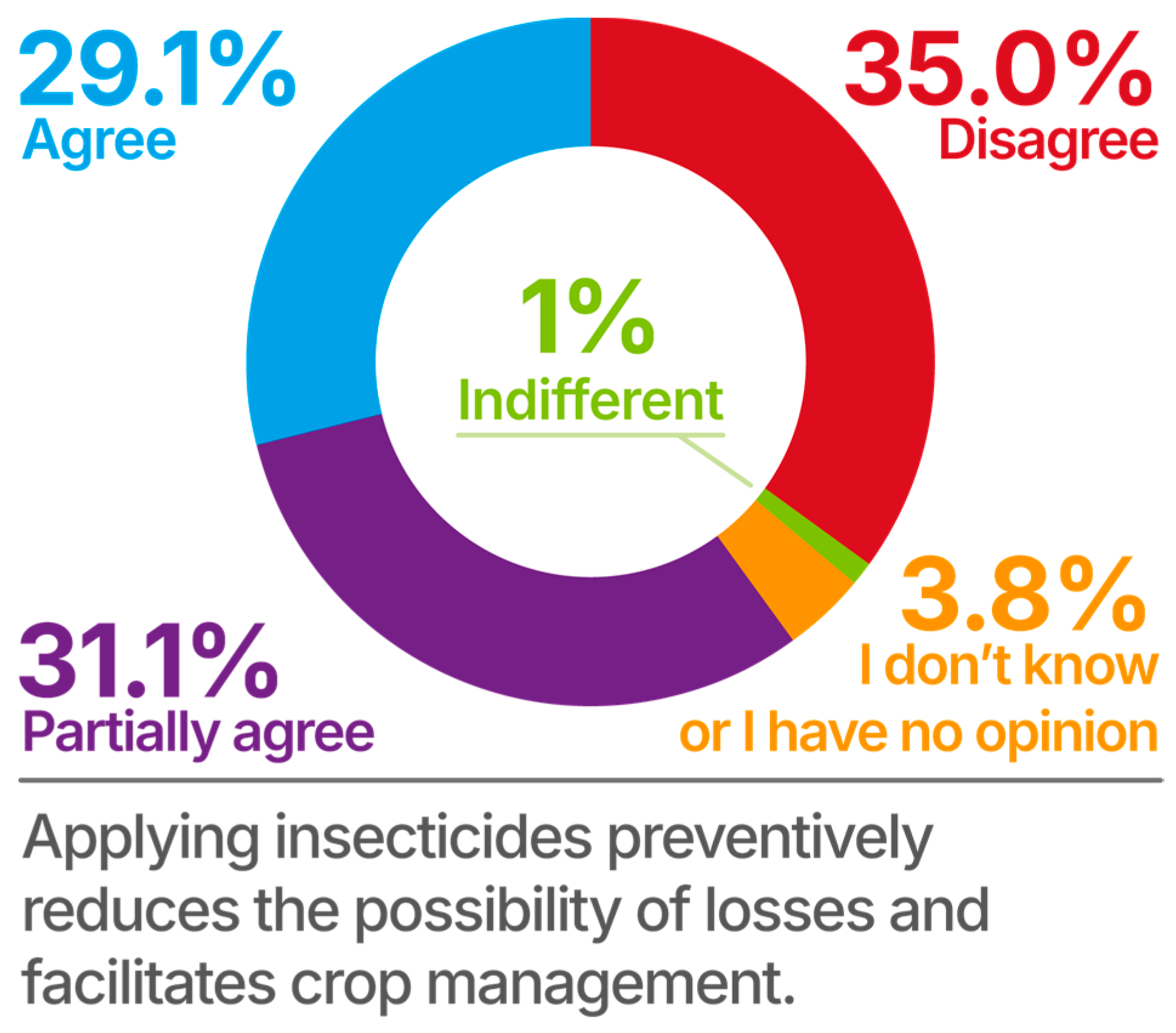
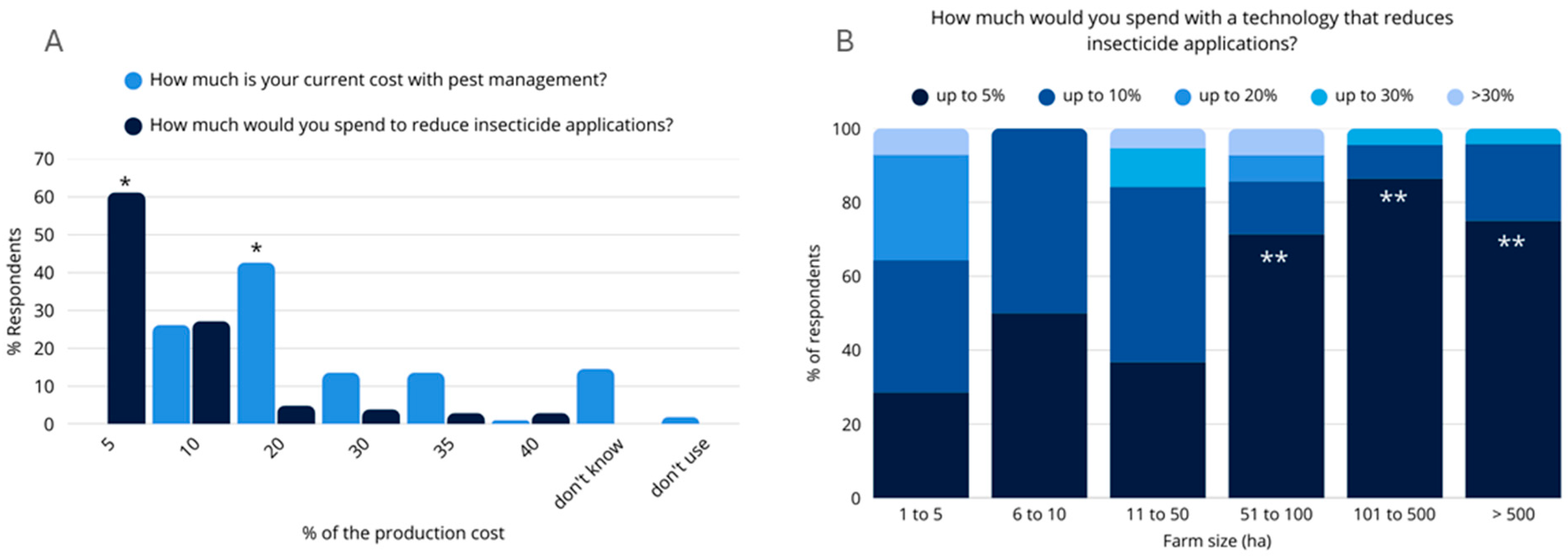
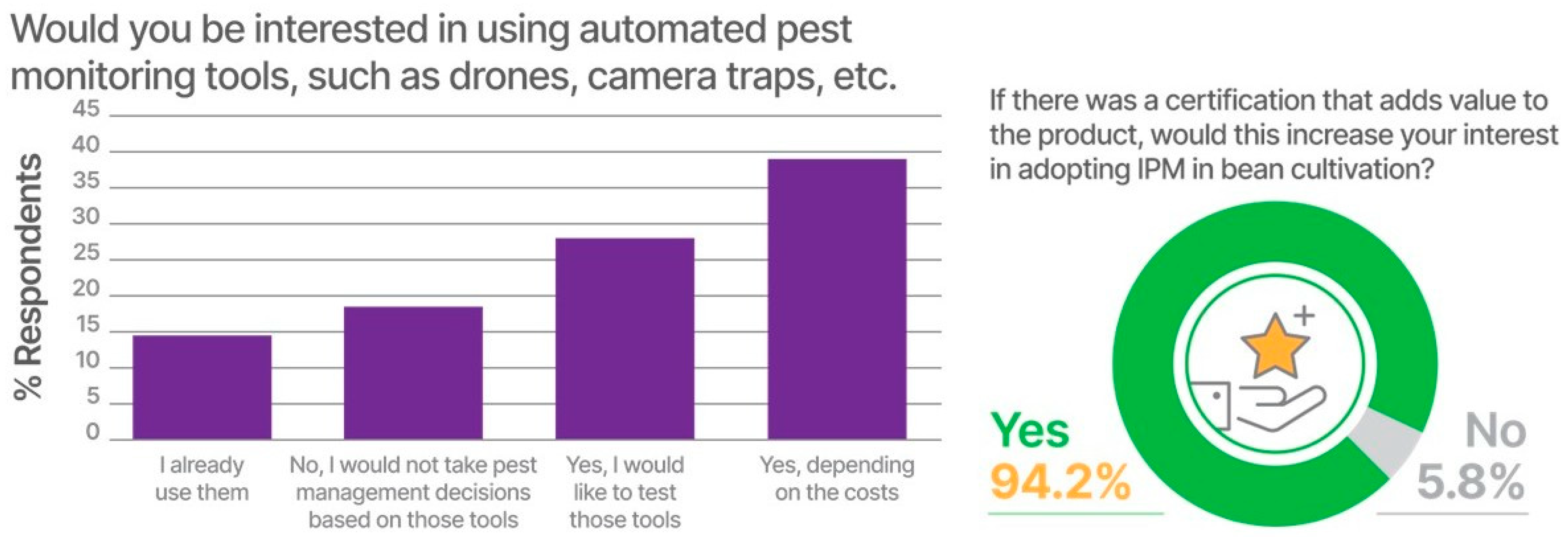
| Size of Bean Cultivation Area (ha) (% Respondents) | ||||||
|---|---|---|---|---|---|---|
| Sources of Technical Know How (%) | 1 to 5 (13.6%) | 6 to 10 (9.7%) | 11 to 50 (18.4%) | 51 to 100 (13.6%) | 101 to 500 (21.4%) | >500 (23.3%) |
| Family tradition | 71.4 | 60 | 57.9 | 42.8 | 50 | 54.1 |
| FT only | 28.5 | 30 | 36.8 | 14.3 | 4.5 | 4.2 |
| Professional training in agriculture PTA | 35.7 | 40 | 63.6 | 57.1 | 86.4 | 79.2 |
| Books, magazines, newspapers, television etc. | 35.7 | 30 | 36.4 | 42.9 | 40.9 | 41.7 |
| Socializing with local farmers | 35.7 | 30 | 63.6 | 50.0 | 31.8 | 54.2 |
| Agriculture Technology | Farmers Adoption (%) | |
|---|---|---|
| IPM | 56.3 | 43.7 |
| Biological control | 59.2 | 40.8 |
| Precision farming | 54.4 | 45.6 |
| No-tillage | 85.4 | 14.6 |
| Transgenic seeds | 20.4 | 79.6 |
| Cover crops | 54.4 | 45.6 |
| Crop rotation | 90.3 | 9.7 |
Disclaimer/Publisher’s Note: The statements, opinions and data contained in all publications are solely those of the individual author(s) and contributor(s) and not of MDPI and/or the editor(s). MDPI and/or the editor(s) disclaim responsibility for any injury to people or property resulting from any ideas, methods, instructions or products referred to in the content. |
© 2025 by the authors. Licensee MDPI, Basel, Switzerland. This article is an open access article distributed under the terms and conditions of the Creative Commons Attribution (CC BY) license (https://creativecommons.org/licenses/by/4.0/).
Share and Cite
Ferreira, A.L.; Wander, A.E.; Pinheiro, P.V. IPM Adoption in Common Beans in Brazil. Horticulturae 2025, 11, 611. https://doi.org/10.3390/horticulturae11060611
Ferreira AL, Wander AE, Pinheiro PV. IPM Adoption in Common Beans in Brazil. Horticulturae. 2025; 11(6):611. https://doi.org/10.3390/horticulturae11060611
Chicago/Turabian StyleFerreira, Amanda Lopes, Alcido Elenor Wander, and Patricia Valle Pinheiro. 2025. "IPM Adoption in Common Beans in Brazil" Horticulturae 11, no. 6: 611. https://doi.org/10.3390/horticulturae11060611
APA StyleFerreira, A. L., Wander, A. E., & Pinheiro, P. V. (2025). IPM Adoption in Common Beans in Brazil. Horticulturae, 11(6), 611. https://doi.org/10.3390/horticulturae11060611







